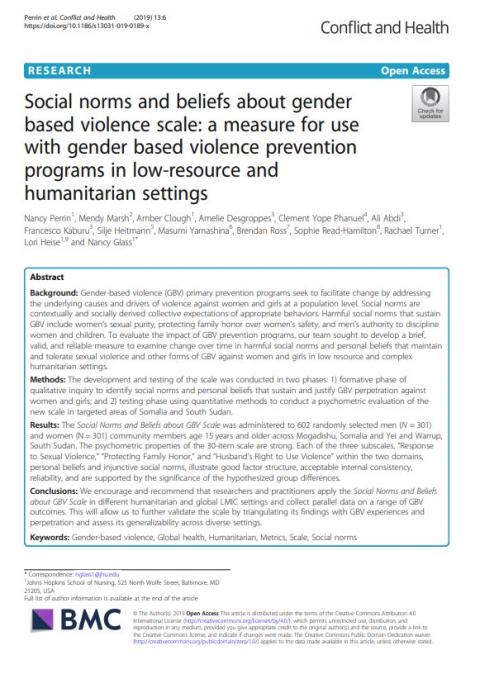- Journal article
- 8 March 2019
Social norms and beliefs about gender based violence scale: a measure for use with gender based violence prevention programs in low-resource and humanitarian settings
- Author: Nancy Perrin et al.
- Published by: BMC

Background
Gender-based violence (GBV) primary prevention programs seek to facilitate change by addressing the underlying causes and drivers of violence against women and girls at a population level. Social norms are contextually and socially derived collective expectations of appropriate behaviors. Harmful social norms that sustain GBV include women’s sexual purity, protecting family honor over women’s safety, and men’s authority to discipline women and children. To evaluate the impact of GBV prevention programs, our team sought to develop a brief, valid, and reliable measure to examine change over time in harmful social norms and personal beliefs that maintain and tolerate sexual violence and other forms of GBV against women and girls in low resource and complex humanitarian settings.
Methods
The development and testing of the scale was conducted in two phases: 1) formative phase of qualitative inquiry to identify social norms and personal beliefs that sustain and justify GBV perpetration against women and girls; and 2) testing phase using quantitative methods to conduct a psychometric evaluation of the new scale in targeted areas of Somalia and South Sudan.
Results
The Social Norms and Beliefs about GBV Scale was administered to 602 randomly selected men (N = 301) and women (N = 301) community members age 15 years and older across Mogadishu, Somalia and Yei and Warrup, South Sudan. The psychometric properties of the 30-item scale are strong. Each of the three subscales, “Response to Sexual Violence,” “Protecting Family Honor,” and “Husband’s Right to Use Violence” within the two domains, personal beliefs and injunctive social norms, illustrate good factor structure, acceptable internal consistency, reliability, and are supported by the significance of the hypothesized group differences.
Conclusions
We encourage and recommend that researchers and practitioners apply the Social Norms and Beliefs about GBV Scale in different humanitarian and global LMIC settings and collect parallel data on a range of GBV outcomes. This will allow us to further validate the scale by triangulating its findings with GBV experiences and perpetration and assess its generalizability across diverse settings.
- Countries / Regions:
- Somalia, South Sudan